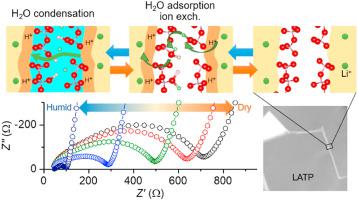Journal of Power Sources ( IF 8.1 ) Pub Date : 2021-09-01 , DOI: 10.1016/j.jpowsour.2021.230422 Hirotoshi Yamada 1 , Naoki Morimoto 2 , Hyosuke Mukohara 2 , Tomonori Tojo 2 , Sei-ichi Yano 2 , Eisuke Magome 3 , Takao Morimura 1 , Raman Bekarevich 4 , Kazutaka Mitsuishi 4

|
Lithium-ion conductors with a crystal structure classified as Na super ion Conductors (NASICON) exhibit high ionic conductivity at room temperature that may be used in next-generation batteries. This study finds unusual ionic conduction of Li1.3Al0.3Ti1.7(PO4)3 (LATP): hysteresis on temperature and atmosphere dependence. The precise conductivity analyses (a wide frequency range, a wide temperature range, and a narrow temperature interval) reveal that the unusual conductivity is attributed to grain boundary conductivity enhanced by moisture. From the detailed studies on bulk (crystal structure) and grain boundary (microcracks, segregation, and impurities) of LATP pellets, it is concluded that the unusual ionic conduction results from adsorbed water on microcracks of LATP pellets. It is also confirmed that at high humidity, grain boundary resistance is further reduced by condensed water in the microcracks. This study reveals the high moisture sensitivity of conductivity of LATP for the first time, which is explained by the concerted influence of microstructure and humidity on ionic conductivity across grain boundaries. The results point out the importance of atmosphere control in scientific studies and for quality control of this class of solid electrolytes in advanced batteries like all-solid-state batteries, Li-air batteries, and others.
中文翻译:

微观结构和吸附水对Li1.3Al0.3Ti1.7(PO4)3锂离子传导的共同影响
具有分类为钠超离子导体 (NASICON) 的晶体结构的锂离子导体在室温下表现出高离子电导率,可用于下一代电池。该研究发现 Li 1.3 Al 0.3 Ti 1.7 (PO 4 ) 3 的异常离子传导(LATP):对温度和大气依赖性的滞后。精确的电导率分析(宽频率范围、宽温度范围和窄温度区间)表明异常的电导率归因于水分增强的晶界电导率。通过对 LATP 颗粒的体积(晶体结构)和晶界(微裂纹、偏析和杂质)的详细研究,得出的结论是,异常的离子传导是由 LATP 颗粒微裂纹上的吸附水引起的。还证实,在高湿度下,微裂纹中的冷凝水进一步降低了晶界电阻。该研究首次揭示了 LATP 电导率的高湿度敏感性,这可以通过微观结构和湿度对跨晶界离子电导率的协同影响来解释。结果指出了大气控制在科学研究中的重要性,以及对全固态电池、锂空气电池等先进电池中此类固体电解质的质量控制的重要性。











































 京公网安备 11010802027423号
京公网安备 11010802027423号